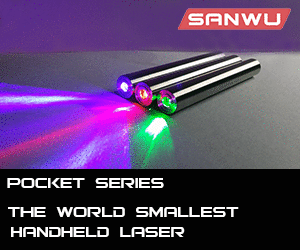I think it could very possibly look quite bright as a single fat beam, if the disc is spun quickly enough. You'll be playing with human persistence of vision, and will need to take advantage of a "rotary" 'pulse width modulation' of sorts. (Totally different effect) But by spinning the array very quickly, the "duty cycle" of there being a beam in a single spot will help the illusion of the beam always being present in one vertical position along the disc's arc.
So... suppose you have 4 lasers on a circular disc. You'll need to return a green beam back to any given point point along the arc of travel, at least some ~30x per second.
So spin the spin a about 7.5 rps or 450 rpm to achieve this.
The larger the diameter of the disc, the fast the beams travel along the arc, and the faster their position changes in time. This may cause a sort of a better 'blur' effect. A smaller disc might be easier to spin so quickly, but the lasers will not achieve the same instantaneous tangential velocity - causing a better "duty cycle" but less travel through the air to "persist" vision with.
In my opinion - I think these two effects will ultimately cancel each other out to some effect. Go with whatever disc size you want to, as long as you can spin it at ~450 rpm or faster - safely.
BB's alternative method is a very good idea to consider. Mirrors would also allow for verrrrrry tight and precise beam position adjustments. Green DPSS lasers are not known for always being emitted perfectly straight out of the laser module. Modules can be made misaligned so long as they still put out a desired amount of power. So getting 3 axis screw adjustable mirror mounts will be a must.
 . Well, yesterday I was playing with my laser. It's a green cheap laser, but has enough power to be very noticeable when I point to the stars in the night. So after that I had an idea, what if you put four or more lasers on a roulette, and you spin it with a dc motor or a drill ? Will it looks like a very tall cylinder ? Has anyone done this ?
. Well, yesterday I was playing with my laser. It's a green cheap laser, but has enough power to be very noticeable when I point to the stars in the night. So after that I had an idea, what if you put four or more lasers on a roulette, and you spin it with a dc motor or a drill ? Will it looks like a very tall cylinder ? Has anyone done this ?






